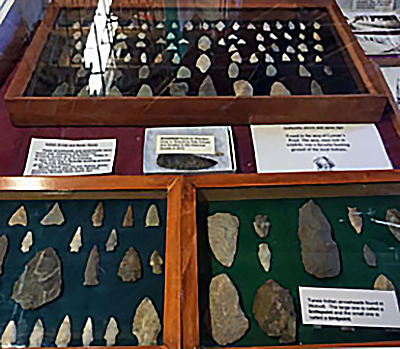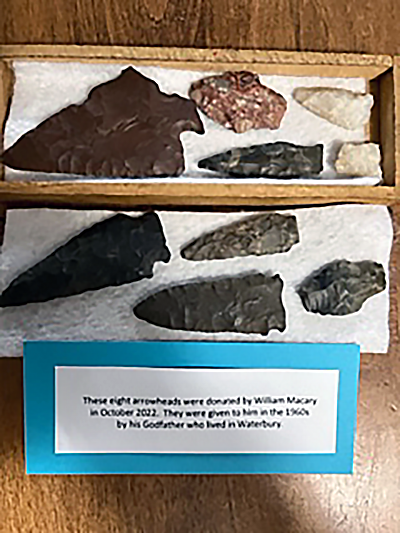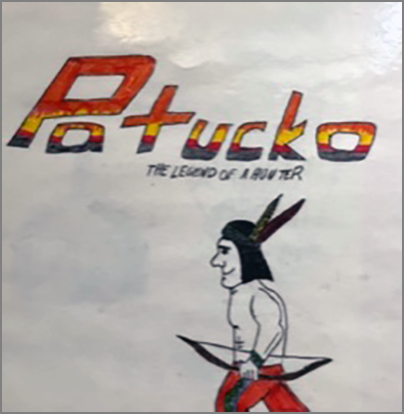|
|
||||||||||||
 |
 |
|
Wolcott Historical Society News - November 2023 By Florence Goodman Last month on Facebook someone asked how Potuccos Ring Road received its name. A high school classmate of mine, Diane Mazzafarro asked me about it, so I thought I'd revisit the legend that explains the naming of this road.
Our town was a common hunting ground used by the Mattabesec and Tunxis tribes. On August 26, 1674, the Tunxis signed a deed that recorded the sale of certain lands to be called "Mattatuckoke" along the Naugatuck River to settlers from Farmington, CT. The first Native American to make his mark was Nesaheagin, their sachem, or chief. The ninth Native American to affix his mark to the deed was Patucko. Since these aboriginal inhabitants did not "own" the land in the sense that the European settlers understood, numerous deeds were often obtained for the same land. Thus, the original settlement of Waterbury or "Mattatuckoke," was sold four times by two different tribes, each time for approximately nine pounds sterling.
The second deed for this land was signed nearly ten years later, on April 29, 1684. Patucko was the first Native American to mark the deed and just six months later, a third deed was signed, but Patucko's name was absent; his son, Attumtacko and his "woman" made their marks. The following legend is about that sachem, Patucko and why his name was absent from the third deed.
It was believed that Patucko, whose name means "round" or "circle" was renowned as a fire-hunter. He would build a fire in a circle and leave an opening large enough for small animals or deer to escape. He would situate himself at that opening of that "ring of fire" and kill his prey as they tried to escape the fire, thus having plenty of food for his tribe. This legend has been shortened from its original format to fit into my monthly article.
Patucko stepped quietly into the dark interior of Nesaheagin's lodge. He walked slowly toward the old man who lay on a bed of skins. The old man was dying and wanted to speak to Patucko about deeding over their land to the settlers. Patucko listened intently to the wise, old chief, but did not want to sign the deed. With great effort Nesaheagin convinced Patucko that it was best for his tribe to do so. Patucko listened to his dying father's request and signed the deed, but by the following spring, he knew he had made a mistake. His hunting grounds were slipping away as more settlers moved onto the land. Days and nights passed and Patucko began to fast and walk his land looking for a sign; finally, from exhaustion, he fell to the ground. Looking up through the green leaves, the late morning sun filled the spaces with brilliant light and the leaves seemed to glow. Suddenly his trance was shattered by the sound of geese in the sky behind him. The enormous birds cast a shadow upon him, and their huge wings created gale force winds around him. The leaves were ripped from the trees and the ground seemed to shake. Had this been the sign for which he was searching?
Patucko returned to his village empty handed; his people expecting him to be laden down with food were confused. He explained that he had been hunting but found no food. Early the next morning he left his village again to find food, but this time he would use his fire-hunter skills to catch his prey. Sadly, he climbed the hills to the north of his familiar hunting grounds and began placing the kindling to circle the peak. The day was bright and dry and the slight breeze from the east would cause the fire to spread around rapidly, cutting off escape in all directions, and assuring success. He would usually ignite the fire by friction, but this time he had brought his ceremonial flint. The fire was lit and soon the breeze caused the flames to race on either side of him; Patucko turned and walked deliberately to the top of the hill. By the time he reached the summit, the fire had already closed the ring. He could see the valley, but the river looked sluggish and black through the onrushing flames. Patucko sat quietly while above him the sun disappeared in the smoke.
Patucko was gone and though a few settlers knew the legend, Patucko's Ring was soon corrupted through casual speech to "Tucker's Ring". It was given as a name of a road in Wolcott near the hill where Patucko was believed to have died. At sometime early in the 20th century, someone changed the name to Potuccos Ring Road, as it remains today.
Chestnut Hill Reservoir which is found in the southwestern part of town was also call Arrowhead. It received this name from the many arrowheads that were found there over the years. The Wolcott Historical Society has a wonderful collection of arrowheads at our Center School History Museum.
In 1990 at Alcott Middle School when I taught Project Explore, three of my students Patric DelCioppo, Stephen Cortigiano and Steven Jasulavic created a pop-up book about this legend that can be found at our Stone Schoolhouse Museum.
The arrowhead collection found at The Center School History Museum.
Part of The Wolcott Historical Society's arrowhead collection.
A pop-up book created by students, Patric DelCioppo, Stephen Cortigiano and Steven Jasulavic in 1990 at Alcott Middle School.
To view past installments of the Historical Society News, click here. |
|
|
[Home]
[News]
[Purpose]
[Calendar]
[Museum]
[Membership]
[History]
[Contacts]
[Links]
All material at Wolcott Historical Society Web sites Copyright © 2000-2023 Wolcott Historical Society |


